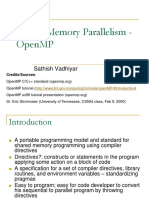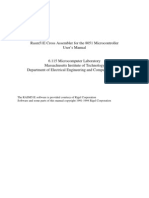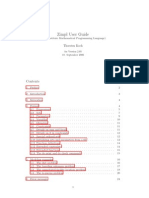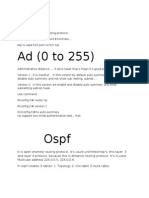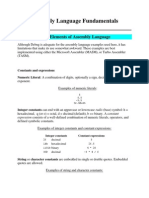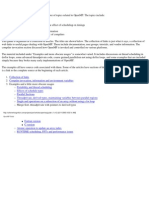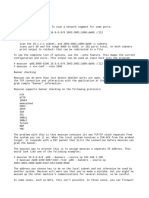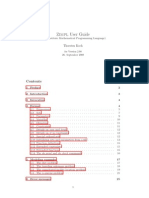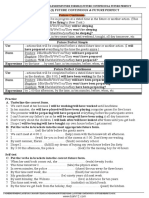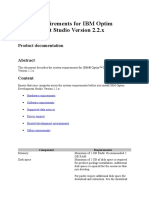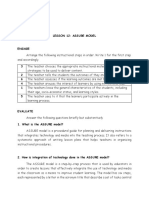Irstlm Manual
Irstlm Manual
Uploaded by
agataddCopyright:
Available Formats
Irstlm Manual
Irstlm Manual
Uploaded by
agataddCopyright
Available Formats
Share this document
Did you find this document useful?
Is this content inappropriate?
Copyright:
Available Formats
Irstlm Manual
Irstlm Manual
Uploaded by
agataddCopyright:
Available Formats
IRST Language Modeling Toolkit
Version 5.20.00
USER MANUAL
M. Federico, N. Bertoldi, M. Cettolo
FBK-irst, Trento, Italy
September 11, 2008
1 Introduction
The IRST Language Modeling Toolkit features algorithms and data structures suitable to estimate, store, and
access very large LMs. Our software has been integrated into a popular open source SMT decoder called
Moses.
1
Acknowledgments. Users of this toolkit might cite in their publications:
M. Federico, N. Bertoldi, M. Cettolo, IRSTLM: an Open Source Toolkit for Handling Large
Scale Language Models, Proceedings of Interspeech, Brisbane, Australia, 2008.
References to introductory material on n-gram LMs are given in the appendix.
2 Getting started
Environment Settings Commands and scripts described in this manual are installed under the directo-
ries bin and bin/$MACHTYPE, that we assume are included in your PATH environment variable. If the
evironment variable MACHTYPE is not already set, it will be set by means of the command"uname -m".
You need also to set the environment variable IRSTLM to the path of this package. Data sets used in the
examples can be found in the example directory.
Examples The directory example contains two English text les, namely train.gz and test, which
we will use to estimate and evaluate our LM, respectively. In particular, LM evaluation computes both the
perplexity and the out-of-vocabulary rate of the test set. Notice that both le are tokenized and contain
one sentence per line and sentence boundary symbols. Given a text le, sentence boundary symbols can be
added in each line with the script add-start-end.sh:
$> add-start-end.sh < your-text-file
1
http://www.statmt.org/moses/
1
3 Estimating Gigantic LMs
LM estimation starts with the collection of n-grams and their frequency counters. Then, smoothing param-
eters are estimated for each n-gram level; infrequent n-grams are possibly pruned and, nally, a LM le is
created containing n-grams with probabilities and back-off weights. This procedure can be very demanding
in terms of memory and time if it applied on huge corpora. We provide here a way to split LM training
into smaller and independent steps, that can be easily distributed among independent processes. The pro-
cedure relies on a training scripts that makes little use of computer RAM and implements the Witten-Bell
smoothing method in an exact way.
Before starting, let us create a working directory under examples, as many les will be created:
$> mkdir stat
The script to generate the LM is:
> build-lm.sh -i "gunzip -c train.gz" -n 3 -o train.ilm.gz -k 5
where the available options are:
-i Input training file e.g. gunzip -c train.gz
-o Output gzipped LM, e.g. lm.gz
-k Number of splits (default 5)
-n Order of language model (default 3)
-t Directory for temporary files (default ./stat)
-p Prune singleton n-grams (default false)
-s Smoothing methods: witten-bell (default), kneser-ney
-b Include sentence boundary n-grams (optional)
-d Define subdictionary for n-grams (optional)
-v Verbose
The script splits the estimation procedure into 5 distinct jobs, that are explained in the following section.
There are other options that can be used. We recommend for instance to use pruning of singletons to get
smaller LM les. Notice that build-lm.sh produces a LM le train.ilm.gz that is NOT in the
nal ARPA format, but in an intermediate format called iARPA, that is recognized by the compile-lm
command and by the Moses SMT decoder running with IRSTLM. To convert the le into the standard ARPA
format you can use the command:
> compile-lm train.ilm.gz --text yes train.lm
this will create the proper ARPA le lm-final. To create a gzipped le you might also use:
> compile-lm train.ilm.gz --text yes /dev/stdout | gzip -c > train.lm.gz
In the following sections, we will talk about LM le formats, compiling your LM into a more compact and
efcient binary format, and about querying your LM.
2
3.1 Estimating a LM with a Partial Dictionary
We can extract the corpus dictionary sorted by frequency with the command:
$> dict -i="gunzip -c train.gz" -o=dict -f=y -sort=no
A sub-dictionary can be dened by just taking words occurring at least 5 times:
$> (echo DICTIONARY; tail +2 dict | awk {if ($2>=5) print}) > sdict
The LM can be restricted to the dened sub-dictionary with the command build-lm.sh by using the
option -d:
> build-lm.sh -i "gunzip -c train.gz" -n 3 -o sublm.gz -k 5 -p -d sdict
Notice that, all words outside the sub-dictionary will be mapped to the <unk> class, the probability of
which will be directly estimated from the corpus statistics.
4 LM File Formats
This toolkit supports three output format of LMs. These formats have the purpose of permitting the use of
LMs by external programs. External programs could in principle estimate the LM from an n-gram table
before using it, but this would take much more time and memory! So the best thing to do is to rst estimate
the LM, and then compile it into a binary format that is more compact and that can be quickly loaded and
queried by the external program.
4.1 ARPA Format
This format was introduced in DARPA ASR evaluations to exchange LMs. ARPA format is also supported
by the SRI LM Toolkit. It is a text format which is rather costly in terms of memory. There is no limit to the
size n of n-grams.
4.2 qARPA Format
This extends the ARPA format by including codebooks that quantize probabilities and back-off weights of
each n-gram level. This format is created through the command quantize-lm.
4.3 iARPA Format
This is an intermediate ARPA format in the sense that each entry of the le does not contain in the rst
position the full n-gram probability, but just its smoothed frequency, i.e.:
...
f(z|x y) x y z bow(x y)
...
This format is nevertheless properly managed by the compile-lm command in order to generate a binary
version or a correct ARPA version.
3
4.4 Binary Formats
Both ARPA and qARPA formats can be converted into a binary format that allows for space savings on
disk and a much quickers upload of the LM le. Binary versions can be created with the command
compile-lm, that produces les with headers blmt or Qblmt.
5 LM Pruning
Large LMs les can be pruned in a smart way by means of the command prune-lm that removes n-grams
for which resorting to the back-off results in a small loss. The syntax is as follows:
> prune-lm --threshold=1e-6,1e-6 train.lm.gz train.plm
Thresholds for each n-gram level, up from 2-grams, are based on empirical evidence. Threshold zero results
in no pruning. If less thresholds are specied, the right most is applied to the higher levels. Hence, in the
above example we could have just specied one threshold, namely --threshold=1e-6. The effect of
pruning is shown in the following messages of prune-lm:
1-grams: reading 15059 entries
2-grams: reading 142684 entries
3-grams: reading 293685 entries
done
OOV code is 15058
OOV code is 15058
pruning LM with thresholds:
1e-06 1e-06
savetxt: train.lm.plm
save: 15059 1-grams
save: 135967 2-grams
save: 185127 3-grams
The saved LM table train.plm contains about 5% less bigrams, and 37% less trigrams! Notice that
the output of prune-lm is an ARPA LM le, while the input can be either an ARPA or binary LM. Notice
that quantization must be eventually performed after pruning! In order to measure the loss in accuracy
introduced by pruning, perplexity of the resulting LM can per computed (see below).
6 LM Quantization and Compilation
A language model le in ARPA format, created with the IRST LM toolkit or with other tools, can be quan-
tized and stored in a compact data structure, called language model table. Quantization can be performed
by the command:
$> quantize-lm train.lm train.qlm
which generates the quantized version train.qlm that encodes all probabilities and back-off weights in 8
bits. The output is a modied ARPA format, called qARPA.
LMs in ARPA or qARPA format can be stored in a compact binary table through the command:
4
$> compile-lm train.lm tran.blm
which generates the binary le train.blm that can be quickly loaded in memory.
7 LM Interface
LMs are useful when they can be queried through another application in order to compute perplexity scores
or n-gram probabilities. IRSTLM provides two possible interfaces:
at the command level, through compile-lm
at the c++ library level, mainly through methods of the class lmtable
In the following, we will only focus on the command level interface. Details about the c++ library interface
will be provided in a future version of this manual.
7.1 Perplexity Computation
To compute the perplexity directly from the LM on disk, we can use the command:
$> compile-lm train.lm --eval=test
Nw=49984 PP=474.90 PPwp=0.00 Nbo=39847 Noov=2503 OOV=5.01%
Notice that PPwp reports the contribution of OOV words to the perplexity: each OOV word is penalized
by a xed OOV penalty. By default, OOV penalty is 0. OOV penalty can be modify by setting a dictionary
upper-bound with --dub. Indeed:
$> compile-lm train.lm --eval=test --dub=10000000
Nw=49984 PP=1064.40 PPwp=589.50 Nbo=39847 Noov=2503 OOV=5.01%
The perplexity of the pruned LM can be computed with the command:
compile-lm train.plm --eval test --dub 10000000
Nw=49984 PP=1019.57 PPwp=564.67 Nbo=42671 Noov=2503 OOV=5.01%
Interestingly, a slightly better value is obtained which could be explained by the fact that pruning has re-
moved many unfrequent trigrams and has redistributed their probabilities over more frequent bigrams.
7.2 Probability Computations
We can compute as well log-probabilities word-by-word from standard input with the command:
$> compile-lm train.lm --score yes < test
> </s> 1 p= NULL
> </s> <s> 1 p= NULL
> </s> <s> <unk> 1 p= -6.130331e+00 bo= 2
> <s> <unk> of 1 p= -3.530050e+00 bo= 2
> <unk> of the 1 p= -1.250671e+00 bo= 1
5
> of the senate 1 p= -8.805695e+00 bo= 0
> the senate ( 1 p= -6.150410e+00 bo= 2
> senate ( <unk> 1 p= -5.547798e+00 bo= 2
....
....
the commands reports the currently observed n-gram, including unk words, a dummy constant frequency
1, the log-probability of the n-gram, and the number of back-offs performed by the LM.
Finally, tracing information with the --eval option are shown by setting debug levels from 1 to 4
(--debug):
1 reports the back-off level for each word
2 adds the log-prob
3 adds the back-off weight
4 check if probabilities sum up to 1.
8 Parallel Computation
This package provides facilities to build a gigantic LM in parallel in order to reduce computation time. The
script implementing this feature is based on the SUN Grid Engine software
2
.
To apply the parallel computation run the following script (instead of build-lm.sh):
> build-lm-qsub.sh -i "gunzip -c train.gz" -n 3 -o train.ilm.gz -k 5
Besides the options of build-lm.sh, parameters for the SGE manager can be provided through the
following one:
-q parameters for qsub, e.g. "-q <queue>", "-l <resources>"
The script performs the same split-and merge policy described in Section 3, but some computation is per-
formed in parallel (instead of sequentially) distributing the tasks on several machines.
A Reference Material
The following books contain basic introductions to statistical language modeling:
Spoken Dialogues with Computers, by Renato DeMori, chapter 7.
Speech and Language Processing, by Dan Jurafsky and Jim Martin, chapter 6.
Foundations of Statistical Natural Language Processing, by C. Manning and H. Schuetze.
Statistical Methods for Speech Recognition, by Frederick Jelinek.
Spoken Language Processing, by Huang, Acero and Hon.
2
http://www.sun.com/software/gridware
6
B Release Notes
B.1 Version 3.2
Quantization of probabilities
Efcient run-time data structure for LM querying
Dismissal of MT output format
B.2 Version 4.2
Distinction between open source and internal Irstlm tools
More memory efcient versions of binarization and quantization commands
Memory mapping of run-time LM
Scripts and data structures for the estimation and handling of gigantic LMs
Integration of IRSTLM into Moses Decoder
B.3 Version 5.00
Fixed bug in the documentation
General script build-lm.sh for the estimation of large LMs.
Management of iARPA le format.
Bug xes
Estimation of LM over a partial dictionary.
B.4 Version 5.04
Parallel estimation of gigantic LM through SGE
Better management of sub dictionary with build-lm.sh
Minor bug xes
B.5 Version 5.05
(Optional) computation of OOV penalty in terms of single OOV word instead of OOV class
Extended use of OOV penalty to the standard input LM scores of compile-lm.
Minor bug xes
7
B.6 Version 5.10
Extended ngt to compute statistics for approximated Kneser-Ney smoothing
New implementation of approximated Kneser-Ney smoothing method
Minor bug xes
More to be added here ....
B.7 Version 5.20
Improved tracing of back-offs
Added command prune-lm (thanks to Fabio Brugnara)
Extended lprob function to supply back-off weight/level information
Improved back-off handling of OOV words with quantized LM
Added more debug modalities to compile-lm
Fixed minor bugs in regression tests
8
You might also like
- EE Lab Manuls Fast NuDocument69 pagesEE Lab Manuls Fast NuMuhammad SaadNo ratings yet
- Programming with MATLAB: Taken From the Book "MATLAB for Beginners: A Gentle Approach"From EverandProgramming with MATLAB: Taken From the Book "MATLAB for Beginners: A Gentle Approach"Rating: 4.5 out of 5 stars4.5/5 (3)
- Xfoil TutorialDocument10 pagesXfoil Tutorialeafz111No ratings yet
- IRST Language Modeling Toolkit User ManualDocument28 pagesIRST Language Modeling Toolkit User ManualLeoThomasNo ratings yet
- Short Tutorial/Starter For LAMMPS - LJ17 SimulationDocument4 pagesShort Tutorial/Starter For LAMMPS - LJ17 SimulationSagar SrinivasNo ratings yet
- Open MPDocument35 pagesOpen MPDebarshi MajumderNo ratings yet
- GNU AssemblerDocument122 pagesGNU AssemblerRaja RoutNo ratings yet
- Users GuideDocument8 pagesUsers GuideidusfhihjuihdsihuadsfNo ratings yet
- Exploiting Loop-Level Parallelism For Simd Arrays Using: OpenmpDocument12 pagesExploiting Loop-Level Parallelism For Simd Arrays Using: OpenmpSpin FotonioNo ratings yet
- GoodDocument44 pagesGoodDeni haryadiNo ratings yet
- Searching For Pulsars With PRESTO: by Scott Ransom Nrao / UvaDocument28 pagesSearching For Pulsars With PRESTO: by Scott Ransom Nrao / UvaVijay NaikNo ratings yet
- Clang - The C, C++ Compiler: SynopsisDocument9 pagesClang - The C, C++ Compiler: SynopsisshankarNo ratings yet
- Open MP2Document28 pagesOpen MP2l215376No ratings yet
- Rasm ManualDocument9 pagesRasm Manualerpankaj80No ratings yet
- Rep ErrorDocument3 pagesRep ErrorishanchatNo ratings yet
- Lab Manual SP - FinalDocument60 pagesLab Manual SP - FinalShaun BhattiNo ratings yet
- Meta Releases Prompt Engineering GuideDocument11 pagesMeta Releases Prompt Engineering GuideCostiReduxNo ratings yet
- Espresso Logic Minimizer ManualDocument3 pagesEspresso Logic Minimizer ManualDan Mihai DumitrescuNo ratings yet
- TasmDocument33 pagesTasmvishnuhost67% (3)
- Chapter 5 - Command Line SkillsDocument21 pagesChapter 5 - Command Line SkillsSai Vamsi GandhamNo ratings yet
- Ibm Aix Smitty How ToDocument33 pagesIbm Aix Smitty How ToRyan RosaldoNo ratings yet
- Z User Guide: Thorsten KochDocument33 pagesZ User Guide: Thorsten KochsdhfgdshNo ratings yet
- BlasDocument12 pagesBlasDevesh KumarNo ratings yet
- 07 OpenMPDocument28 pages07 OpenMPHamid KishaNo ratings yet
- Bulk Binds and Collects in PLSQLDocument6 pagesBulk Binds and Collects in PLSQLsagarka21No ratings yet
- Beginners Guide To AMOSDocument7 pagesBeginners Guide To AMOSSham DegiggsyNo ratings yet
- Local LLM Inference and Fine-TuningDocument26 pagesLocal LLM Inference and Fine-TuningPeter Smith100% (1)
- Spring 2018 Lab Assignment #4: Understanding Cache Memories Assigned: Apr. 25 Deadline: May 9, 04:59:59 PMDocument10 pagesSpring 2018 Lab Assignment #4: Understanding Cache Memories Assigned: Apr. 25 Deadline: May 9, 04:59:59 PMSohaib ChoudharyNo ratings yet
- Assembly Language Revision NotesDocument8 pagesAssembly Language Revision Notes2024sl70006No ratings yet
- Micro Topic 6 PDFDocument17 pagesMicro Topic 6 PDFroshaanNo ratings yet
- Cache LabDocument10 pagesCache Labarteepu37022No ratings yet
- AIX Userful CommandDocument35 pagesAIX Userful CommandMayur SoriyaNo ratings yet
- AVR-GCC and The PROGMEM AttributeDocument10 pagesAVR-GCC and The PROGMEM AttributeleonttiNo ratings yet
- Zimpl User Guide: Thorsten KochDocument32 pagesZimpl User Guide: Thorsten KochFelipe OssesNo ratings yet
- Ad (0 To 255)Document2 pagesAd (0 To 255)lovedeep30No ratings yet
- Useful AIX CommandsDocument48 pagesUseful AIX CommandsRrshell ForuNo ratings yet
- Assembly Language FundamentalsDocument8 pagesAssembly Language FundamentalsGlyssie Lynne NocedoNo ratings yet
- Untitled Document 2Document6 pagesUntitled Document 2joyebrawnNo ratings yet
- OpenmpDocument127 pagesOpenmpivofrompisaNo ratings yet
- Guidelines For Programming in High Performance Fortran: by Dave PruettDocument4 pagesGuidelines For Programming in High Performance Fortran: by Dave Pruettkadung3394No ratings yet
- Gasm ManualDocument12 pagesGasm ManualAbhijeet SaNo ratings yet
- RHEL Multipathing BasicsDocument23 pagesRHEL Multipathing Basicsiftikhar ahmedNo ratings yet
- The Makefile Utility: Courtesy: UCCSDocument28 pagesThe Makefile Utility: Courtesy: UCCSdevenderNo ratings yet
- Useful AIX CommandsDocument44 pagesUseful AIX Commandsmugeshpv90No ratings yet
- MplusAutomation ExamplesDocument27 pagesMplusAutomation Examplesraum123No ratings yet
- LAMMPS Developer GuideDocument14 pagesLAMMPS Developer GuideSaeed AbdNo ratings yet
- Ejercicio 1 3Document17 pagesEjercicio 1 3SamuelNo ratings yet
- 7 Unix Basic UtilitiesDocument3 pages7 Unix Basic UtilitiesMaheshwar BhatNo ratings yet
- AIX SambaPware PDFDocument37 pagesAIX SambaPware PDFoliversusNo ratings yet
- Comp Review: Compilers: Fall 1996 Textbook: "Compilers" by Aho, Sethi & UllmanDocument10 pagesComp Review: Compilers: Fall 1996 Textbook: "Compilers" by Aho, Sethi & UllmanIc 555No ratings yet
- Lammps ManualDocument454 pagesLammps ManualDavid QuintNo ratings yet
- Introduction To LAMMPS and OVITODocument2 pagesIntroduction To LAMMPS and OVITOVictor Daniel WaasNo ratings yet
- Masscan1 MemasticamDocument18 pagesMasscan1 MemasticamJorge PabNo ratings yet
- Prapti Gandhi Exp 1 60Document11 pagesPrapti Gandhi Exp 1 60praptigandhi14No ratings yet
- ZimplDocument33 pagesZimplAzdffNo ratings yet
- The Mac Terminal Reference and Scripting PrimerFrom EverandThe Mac Terminal Reference and Scripting PrimerRating: 4.5 out of 5 stars4.5/5 (3)
- LEARN MPLS FROM SCRATCH PART-B: A Beginners guide to next level of networkingFrom EverandLEARN MPLS FROM SCRATCH PART-B: A Beginners guide to next level of networkingNo ratings yet
- Perl One-Liners: 130 Programs That Get Things DoneFrom EverandPerl One-Liners: 130 Programs That Get Things DoneRating: 4 out of 5 stars4/5 (3)
- Configuration of a Simple Samba File Server, Quota and Schedule BackupFrom EverandConfiguration of a Simple Samba File Server, Quota and Schedule BackupNo ratings yet
- SAP interface programming with RFC and VBA: Edit SAP data with MS AccessFrom EverandSAP interface programming with RFC and VBA: Edit SAP data with MS AccessNo ratings yet
- Emap 1125736 16635174Document2 pagesEmap 1125736 16635174sabbz123No ratings yet
- UNIT 4 - A Trip To The MarketDocument6 pagesUNIT 4 - A Trip To The MarketCeciliaIsabelNo ratings yet
- CASThe Journeyby Radwa AshourDocument13 pagesCASThe Journeyby Radwa AshourAga GraczykNo ratings yet
- Simplex MethodDocument22 pagesSimplex MethodShreematNo ratings yet
- VDOT Cube Training FinalDocument164 pagesVDOT Cube Training FinalsuryaNo ratings yet
- Ix Support Material Mathematics 2022-23Document197 pagesIx Support Material Mathematics 2022-23mithulvmanu8No ratings yet
- Jain Public School 14Document6 pagesJain Public School 14AnilGoyalNo ratings yet
- G3 Las15 - 2020Document9 pagesG3 Las15 - 2020Erizon Darril PascuaNo ratings yet
- A Student Guide: PrepositionsDocument20 pagesA Student Guide: PrepositionsRome AdrianNo ratings yet
- Brkcol 2610Document109 pagesBrkcol 2610Nurdheen PeringattilNo ratings yet
- Superior Drummer 3 Operation ManualDocument302 pagesSuperior Drummer 3 Operation ManualyveazvdNo ratings yet
- Asking For and Using Information Related To Seasons. - Providing A Short Fluent Description of SeasonsDocument5 pagesAsking For and Using Information Related To Seasons. - Providing A Short Fluent Description of SeasonsNatalia LavricNo ratings yet
- Rundown of English Camp Programming-1Document3 pagesRundown of English Camp Programming-1Dewa NindyaNo ratings yet
- Nobel LessonDocument5 pagesNobel Lessonapi-224234568No ratings yet
- IRS Cataloging and Indexing 2.1Document12 pagesIRS Cataloging and Indexing 2.1Shiva VemulaNo ratings yet
- December 8th Bulletin - Second Sunday in AdventDocument6 pagesDecember 8th Bulletin - Second Sunday in AdventZion SanbornNo ratings yet
- Future Forms (2) Future Continuous and Future PerfectDocument2 pagesFuture Forms (2) Future Continuous and Future PerfectYounes LouziNo ratings yet
- DLL - All Subjects 2 - Q4 - W3 - D3Document7 pagesDLL - All Subjects 2 - Q4 - W3 - D3bacalerhoebieNo ratings yet
- Worksheet #02 - Questions: Mr. Mahmoud Moussa Igcse Ict 0983Document6 pagesWorksheet #02 - Questions: Mr. Mahmoud Moussa Igcse Ict 0983Omar YassinNo ratings yet
- Til 311Document5 pagesTil 311cagatay.ongelNo ratings yet
- Date Sheet March 2024Document1 pageDate Sheet March 2024Junaid ShakeelNo ratings yet
- UNIX ASSIGNMENT (1) 20 PagesDocument20 pagesUNIX ASSIGNMENT (1) 20 Pagesanushka guptaNo ratings yet
- System Requirements For IBM Optim Development Studio Version 2.2.xDocument6 pagesSystem Requirements For IBM Optim Development Studio Version 2.2.xaink_kasepNo ratings yet
- The Shining Mountain AnalysisDocument2 pagesThe Shining Mountain Analysisalexander.arbergNo ratings yet
- Ttl1 Activity 12 (Loberiano)Document5 pagesTtl1 Activity 12 (Loberiano)Loberiano GeraldNo ratings yet
- Department: Program:: Course Code: Prerequisite: I. Institutional VisionDocument5 pagesDepartment: Program:: Course Code: Prerequisite: I. Institutional VisionBenjTomolNo ratings yet
- Descriptions of All Courses in The ProgramDocument139 pagesDescriptions of All Courses in The ProgramHoai NhiNo ratings yet
- Development of Ideas in WritingDocument14 pagesDevelopment of Ideas in Writingmaahiaqsa91No ratings yet
- Individual Assignment Technology Park Malaysia: CT024-3-3-DCOMS Distributed Computer System NP3F1801ITDocument39 pagesIndividual Assignment Technology Park Malaysia: CT024-3-3-DCOMS Distributed Computer System NP3F1801ITRupak ThapaNo ratings yet





